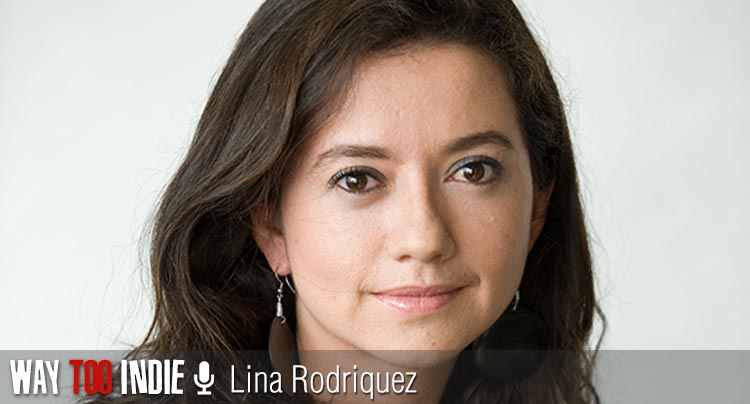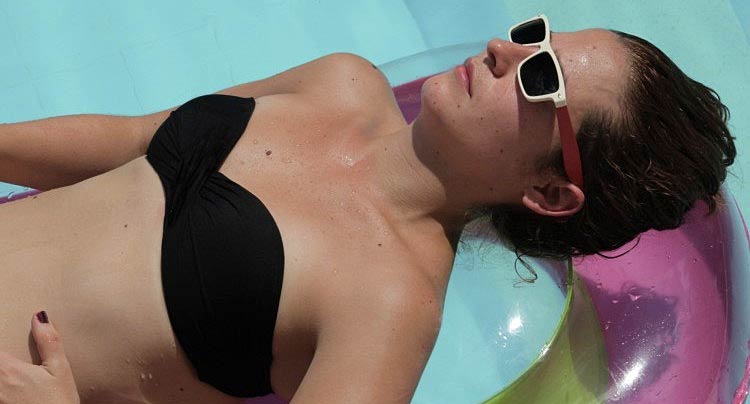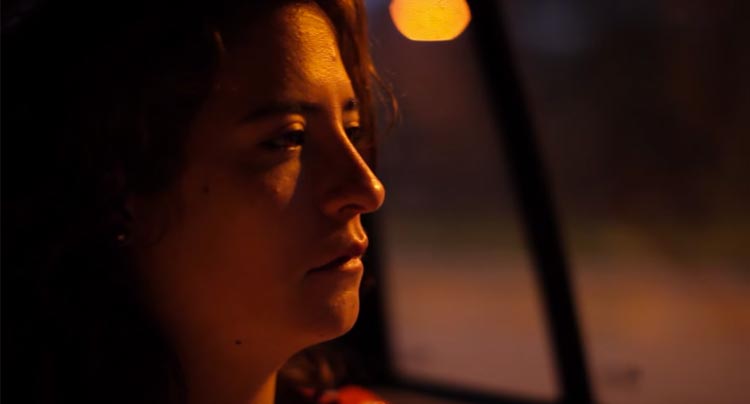Lina Rodriguez speaks about her experimental film background and debut feature ‘Señoritas’

Opening this Friday at the TIFF Bell Lightbox in Toronto, Señoritas is the debut feature of filmmaker Lina Rodriguez. The film follows Alejandra, a young girl living in Bogotá, Colombia, spending most of her days partying and hanging out with her friends. Rodriguez is based in Toronto, but she went back to her hometown to film the independently funded feature. Rodriguez’s personal connection to her film shines through, and her skills behind the camera establish her as someone to watch in the coming years.
Lina Rodriguez was kind enough to talk with us about her background as an experimental filmmaker, her distinct style, and what she hopes to accomplish next. To find out more about Señoritas, check out the trailer at the end of the interview, or head here to buy tickets.
Could you go into your background with experimental film and how you handled the transition to filming a narrative feature?
I studied film production at York University here in Toronto, and once I graduated, I started working a lot on Super 8mm and made several experimental short films. [It was] really more for survival, in the sense that working on Super 8mm gave me a beautiful freedom to take the camera during my travels and document moments without pressure. It allowed me to keep making films, at my pace, and with my own hands. During those years after university, I also started doing some installation and performance art work, which kept me active and curious.
Señoritas is a continuation of the artistic and philosophical concerns that I have explored in my experimental films as well as in my installation and performance art, which have focused on the exploration of self and the performance of the self (the act of being) both through my work in film and video formal experiments with light and shadow, the texture and lighting to create atmosphere, and editing to create rhythm and tone. I am interested in thinking about how people’s emotional lives occupy a space on the surface of their bodies, on the impact that these bodies have in space and time, and in the presence and power of an action, its consequences, both inside and outside the frame.
Were there any reasons beyond your personal connection to Bogotá that made you want to shoot there?
Señoritas stems from my experience of growing up as a woman in Bogotá, but also, from my interest in searching for a different way to represent the experience of being and moving as a woman in Bogotá today.
Throughout the process of making the film, it was very clear to me that I wanted to be open to the stories and experiences that I was going to encounter during my research, as well as during the casting and shooting processes, and it is thanks to this work methodology that the film was able to draw from the energy that the present brings in a very natural and organic way. What moves me to make films is that process of discovery and the hope that the actions and relationships that you write on paper will acquire a new life and a new sense of mystery once they are inhabited by people with flesh and blood.

There’s an air of mystery to Alejandra. We get a sense of what she’s feeling and experiencing, but nothing is explicitly laid out.
A portrait of a young woman could have been done using the fast, obvious and immediate aesthetic that is common in more commercial films, television, YouTube and music videos, the aesthetic that sells us how young people are supposedly living today. I could have also used more pronounced brushstrokes to tell the audience more clearly and directly “how to interact” with the protagonist, and what to think of her and the choices that she makes. But as my interest was to reflect on how Alejandra’s daily life and her body and body language’s relationship to her surroundings give us hints about her inner life, it was very clear to me that I wanted to create an atmosphere that would invite the audience to take the time to observe instead of judge. I feel that in a way Señoritas is an invitation to decipher what’s behind her face, her body, and I’m glad that the sense of mystery is still there as my goal was to get close to her, yet keep her as a question mark, because I wanted to articulate that inability to “understand” who she is at this time of her life.
For me filmmaking is interesting because I face it as a process of constant discovery, and I disagree with the idea that there is only one access road for the audience to connect with a film, or a character. Sure, that’s what they teach in screenwriting classes or at the multiplexes, but that’s not what interests me. That’s what unidirectional news are for, to spread laziness and a passive acceptance to let others think and solve things on our behalf. The possibilities of creating meaning from the relationship (montage) of images and sounds is infinite. I’m not interested in making a film about someone who is this or that, so my job becomes to tell the audience how to feel when and why. During production, and even after it, I wanted to keep that air of mystery around María, who plays Alejandra. There is still a lot about her, as a character and as an actress, that I do not know, and I find that interesting. It’s that curiosity and risk of not knowing for sure what keeps moving me to make films.
When I started thinking about Señoritas, I started with a web of images, sounds, ideas, emotions and questions and I realized fairly quickly, that I was already on the opposite side of the tradition and habits that are normally used in “narrative” cinema, but I decided to go for it anyway. I feel that if I had known the answers to my questions before making the film, there would have been no need to make the film and I should have rather written a manifesto or a speech, or an instruction manual to repair a refrigerator, so everything is clear and laid out.
There are some aspects of Señoritas that stuck out to me, and I’d like it if you could talk a bit about them. One of them is the sound design. Interior scenes always have an awareness of what’s going on outside, like the sounds of traffic outside Alejandra’s apartment.
Yes, for me sound is an essential element in the atmospheric and spatial construction of a film. I wanted to create a contrast between the tension and relationship that exists in Alejandra’s public life (her life in front of others, with others, for others) and her private life. I worked with Roberta Ainstein, who did the Sound Design, to build a dynamic web of rhythms and contrasts that invite the audience to find their way around on their own and force them to think about the relationship between sound and image. I wanted to create an atmosphere that would serve as a bridge so they can access emotions and ideas in a different way and participate more actively in how meaning is revealed, not only through what is said and seen, but also by engaging their attention with those off screen voices and sounds.

Another aspect is the depth of field. There’s a lot of shallow focus throughout the film. Could you explain a bit about the film’s use of focus?
I used Egon Schiele’s expressionism as a visual reference. In the same way that this Austrian painter granted vital importance to the world of internal emotions using composition, color and the body (the face as much as the entire body), I wanted, as I said before, to reveal the emotional life of the characters through the very form of their bodies, the cadence of their movements, how their bodies occupy spaces (their position within the frame, their presence), and their relationship with other bodies. In order to achieve this, Alejandro Coronado (the Director of Photography) and I, decided to use a shallow focus as a tool to highlight gestures, stillness and movement.
Duration is a key part of the film’s style as well. Did you always plan to use long, uninterrupted takes? What interests you about that specific style?
I wanted to take the time to observe movement within the frame, as a way to decipher what body language can reveal about the character’s inner lives. The long takes were an organic approach that came from my research, casting and the process of directing the actors, so its not something that I knew ahead of time, it came from the process itself. As my interest was more focused on the creation of atmosphere and rhythm, the long take became a great tool to push the possibility of the construction of meaning beyond the text, and beyond what some call the “juice of a scene,” which is the moment when a scene reveals to us it’s practical purpose, so it can die and we move on. I’m interested in the aftermath of that “purpose,” in the time that it takes us to get there, and the time it takes to get past that point.
You edited Señoritas with Brad Deane. What was the editing process like for the two of you?
After going through the process of writing and shooting, one can be tempted to make editing decisions that conform to those pre-meditated ideas that triggered the film. One can be tempted to execute these ideas and force the footage to fit the original plan. As I said, my interest in cinema comes from the process of discovery, so when Brad and I started the editing process, it was very important for us to allow ourselves to see the footage with “new eyes.” As Peter Kubelka says, once you start editing, you must surrender and ask “Film, here you are, what can you do for me?”
We feel that a cut is an action in itself, and as such, it’s a very important decision that cannot be taken lightly. We used each cut as a tool to interrupt the flow of the actions, to create a rhythm and deepen the atmosphere that had been created through the mise-en-scène and sound design. We edited the film following a strategy that accentuates and punctuates each scene and heightens the contrast between the scenes, instead of the more traditional way of cutting, which is aimed at making the parts invisible and continuous to give the illusion of a whole.
Finally, what are your plans for the future? Are you working on anything else at the moment?
I just got back from doing auditions and some location scouting for This Time Tomorrow, my second feature film, which we’ll shoot in January 2015 in Bogotá. Señoritas multiplied my strength to continue searching in my own way and at my own rhythm, and I plan to continue growing slowly, and working within an independent production model, that allows me to surround myself with close people who I trust and who are willing to continue taking risks with me.
